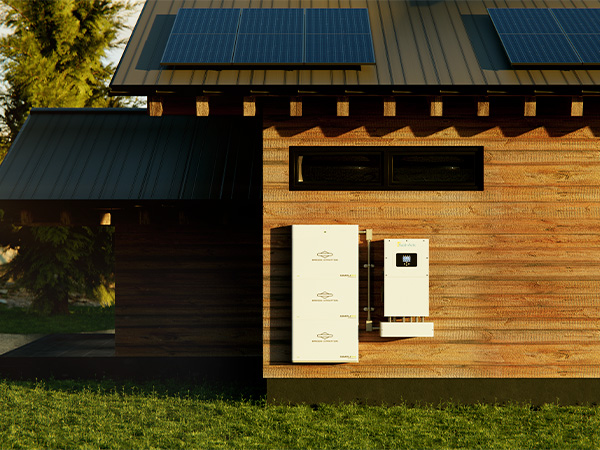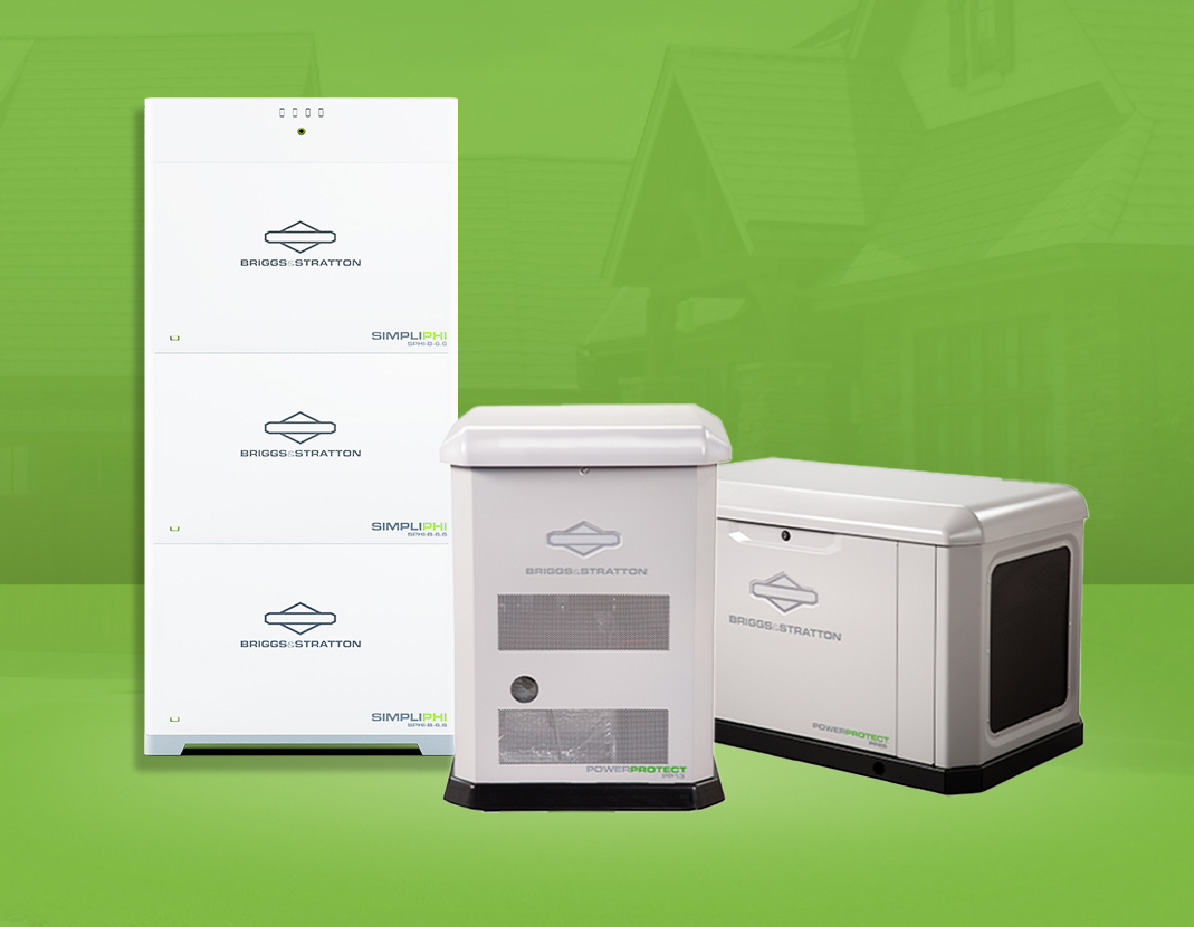As the nation’s centralized power grid continues to fail due to extreme weather, placing additional stress on old, outdated utility infrastructure, distributed, customer-sited backup power solutions are becoming more critical for people to protect their homes and businesses from blackouts and economic losses. While generators have historically been the most common backup solution, energy storage is fast becoming an additional solution to create energy reserves, even optimizing generators and reducing run-time and fuel costs. But what is energy storage? According to Energy.gov, “‘storage’ refers to technologies that can capture electricity, store it as another form of energy (chemical, thermal, mechanical), and then release it for use when needed.”
Distributed customer-sited energy storage devices, like fuel cells, batteries and capacitors, can increase efficiency, improve power quality and supply reliable power to customers at times when it’s needed most, like during centralized grid outages. In addition, energy storage installed at the home or business can save you money every day by discharging batteries during peak load times, when the grid is at maximum capacity and the utility charges higher Time of Use (ToU) rates. In this way, customer-sited energy storage technologies also reduce overall stress on the utility grid by powering loads in the home during maximum capacity, further minimizing the chances of an outage.
How an Energy Storage System (ESS) Works
Energy storage systems (ESS) can store power from any generation source, such as solar panels, a generator or the utility grid itself. That power can be used immediately to run electrical loads in your home or it can be stored in the batteries for a later use. Similar to common rechargeable batteries, the large batteries in energy storage systems designed for homes and businesses store electricity until it is needed, either for backup power during a grid outage or to power electrical loads during high utility rates. The ESS delivers reliable power from the batteries as if it’s coming directly from the power grid, but when the stored energy is needed, not just when it is generated by the generator, solar, grid or some combination. These ESS systems can use Lithium-Ion, lead acid or other battery technologies.
The Briggs & Stratton SimpliPHI™ ESS only utilizes Lithium Ferro Phosphate (LFP) chemistry to deliver more efficient, safer and reliable energy storage. The LFP chemistry eliminates cobalt, a conflict mineral used in other Lithium-Ion batteries, reducing the risk of thermal runaway with fire propagation, operating temperature constraints and toxic coolants.
Because the SimpliPHI ESS is built with a proprietary battery technology that combines an advanced Battery Management System (BMS) with a non-cobalt-based Lithium Ferro Phosphate (LFP) battery chemistry that other batteries do not, they easily out-perform other Lithium-Ion batteries in the market for both residential and small commercial installations. From reliable backup power during grid outages and daily cycling to offset home electrical loads during high utility rate periods (ToU), to advanced controls to achieve peak shaving and demand charge management requirements, the SimpliPHI ESS saves customers money and keeps the lights on.
The SimpliPhi ESS enables home and business owners to automatically switch between power generation sources and/or stored reserves in the batteries to run their electrical loads using the most cost-effective and reliable energy source available, at the specific time it is needed.
Components of an Energy Storage System (ESS)
An ESS should be made up of high-performing, integrated components, including a battery, inverter charge controller and an intelligent management system, that work together to deliver an efficient, easy-to-use experience for home and business owners. The battery storage allows energy to be used at a different time than when it was generated. So, storage can increase system efficiency and resilience, and it can improve power quality for homes and businesses by matching supply and demand.
In order to optimize cost savings and performance, an energy storage system (ESS) should be modular and scalable to accommodate different customers’ needs, both upfront and over time as utility rates and the number and duration of power outages increase, maximizing personal purchasing decisions and budgets. Both the batteries and inverter charge controllers should function as building blocks that support changes in energy capacity and power output requirements — allowing home and business owners to scale their ESS to meet increasing electrical loads and longer duration backup power as their energy use and budgets change over time. For an ESS to be truly responsive to customer’s needs, the batteries and the inverter charge controllers should have the ability to be added and wired in parallel to increase energy capacity and power output for larger electrical loads. ESS components should be modular and scalable to size separately, with a software management and control system to seamlessly integrate whatever the system configuration requirements may be.
The Briggs & Stratton ESS EnergyTrak™ energy management software creates this type of customizable versatility by providing advanced system monitoring and control through a streamlined mobile app that delivers real-time status updates to give users the information needed to effectively manage their SimpliPHI ESS. Check out the rest of the Briggs & Stratton lineup of ESS components.
Energy storage systems are ideal for both home and business owners, with the best ESS’s offering an indoor or outdoor safety rating to create as many installation options as possible per local building code requirements.
IRA & ITC: Additional Energy Storage Cost Savings
As the changes in climate continue to cause more extreme weather, creating higher energy costs and more utility outages, distributed energy storage in homes and businesses is growing in popularity as a way to create daily utility savings and critical backup power. Recognizing the trends in climate related disasters, utility power outages and rising energy costs, the government is encouraging the adoption of cleaner distributed energy solutions for both home and business owners with tax incentives and rebates. Under the recently passed Inflation Reduction Act (IRA), consumers can earn a 30% tax credit to offset the upfront cost of energy storage solutions, including stand-alone batteries and ESS integrated systems.
There are also incentives at the state and local levels. For example, in Connecticut, residential customers can receive a credit of up to $7,500 to install energy storage, and commercial customers can receive incentives of up to 50% of a project’s cost for storage installations. Be sure to check out what incentives you could be eligible for in your city and state.
Power Independence
ESSs allow consumers to take power into their own hands and make informed decisions about their own generation and consumption to maximize their energy security and utility rate cost savings. Generating, storing and utilizing their own power from multiple generation sources (utility, solar, generator) and seamlessly integrating them with intelligent monitoring and control software helps home and business owners reduce utility costs, increase resilience during power outages and realize the benefits of renewable energy, further eliminating CO2 emissions driving climate change.
Stored energy can provide critical backup power in case of an outage, supplement an existing electrical system to reduce utility energy costs, or be used as a primary power source for a home or business.
What to Look For in an ESS
When shopping for an ESS, it’s important to consider what type of chemistry is utilized in the batteries. For example, Lithium-Ion chemistries that utilize cobalt, such as NMC, can pose more risk for thermal runaway and fire propagation than other chemistries such as LFP, that do not contain cobalt. In addition, the Battery Management System (BMS) built into every Lithium-Ion battery should offer robust safety features, such as over-charge and discharge protection. The SimpliPHI ESS features a scalable 4.9kWh battery, which leverages the Lithium Ferro Phosphate (LFP) chemistry to deliver advanced-level power storage with a superior safety profile, longer cycle life and a sophisticated BMS with closed-loop communications that intelligently manages the battery’s performance in synch with the SimpliPHI ESS 6kW inverter. An integrated battery management system (BMS) protects the battery, creates additional safety and extends cycle life. The BMS logically integrates with the 6kW SimpliPHI Hybrid Inverter and EnergyTrak management software.
It’s important to consider all the components of an ESS when shopping around. System-wide energy management and control software is an important feature to consider because it monitors the overall health of the ESS system and allows home and business owners to manage their energy generation sources (grid, solar, generator), storage reserves, and usage at any given time.
The SimpliPHI EnergyTrak management software platform seamlessly and intelligently integrates with the SimpliPHI ESS 6kW Hybrid Inverter and 4.9kWh Battery at virtually any scale, in any combination, allowing customers to increase both energy storage capacity and power output separately to meet their individual needs. It helps optimize overall system performance to accelerate daily utility savings and creates critical backup reserves, to safeguard energy security for customers. The EnergyTrak mobile app delivers real-time system status updates.
Be sure to review the type and length of warranty offered on the ESS components and system as a whole, particularly the fine-print that provides details on installation and usage requirements to protect the Warranty, such as ambient temperature controls, battery charge and discharge rates and Wi-Fi connectivity. Finally, consider the company selling the ESS. Do they actually stand behind their ESS products with dedicated customer support and service? Briggs & Stratton offers a 10 year warranty with a dedicated, best-in-class customer support team for the life of your ESS system.
When it comes to purchasing an ESS, Briggs & Stratton certified dealers will be the best resources to help answer questions about the product, the installation and meeting your specific objectives for the life of the system.

Ready to experience true energy independence?
Request a consultation with a Briggs & Stratton dealer or installer near you by clicking the button below.




